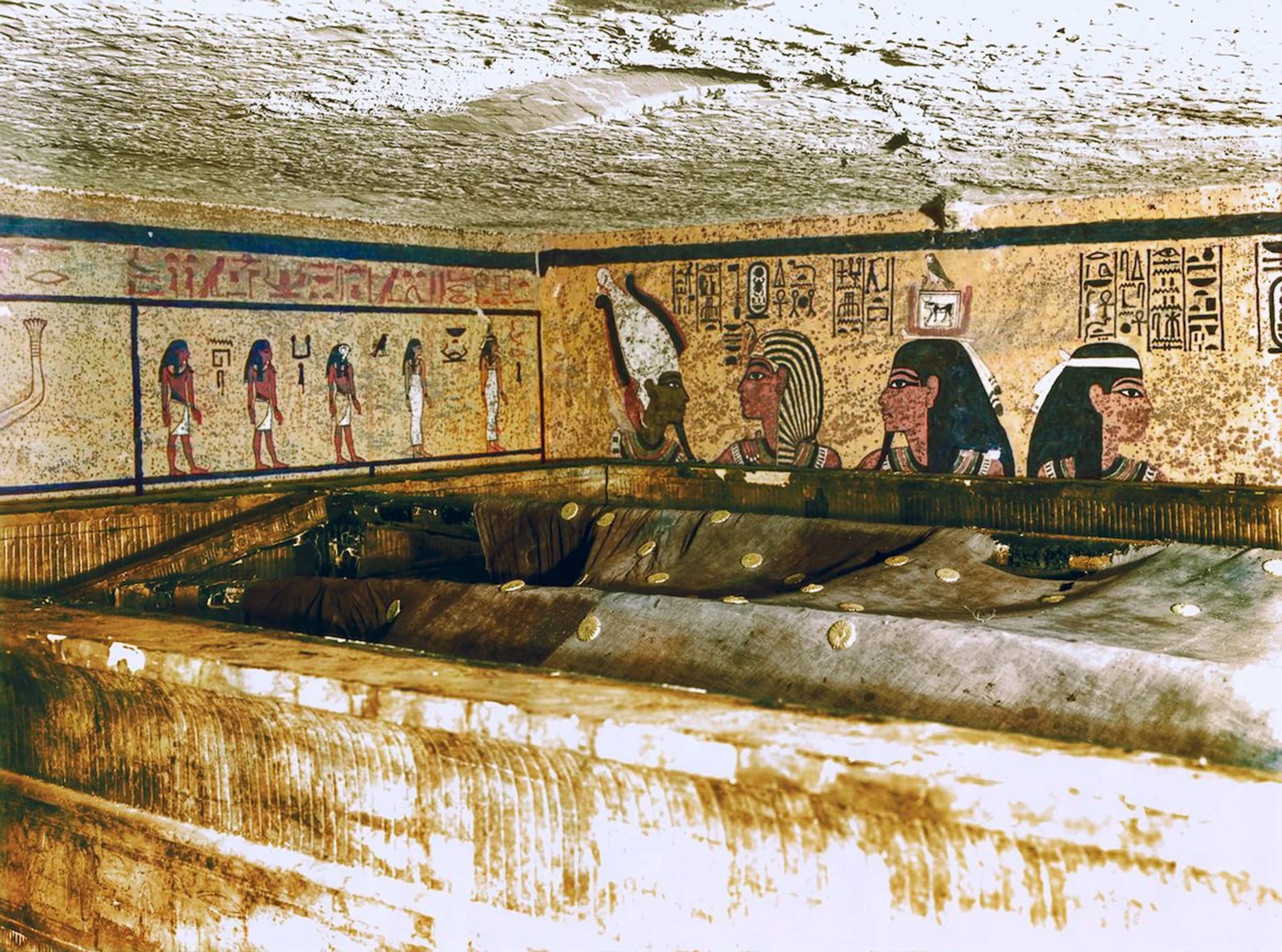Let’s journey into the captivating world of King Tutankhamun’s tomb—a world that extends far beyond glittering gold and an iconic mask. It’s a world teeming with stories of the individuals who meticulously managed Tut’s life, ensuring the smooth operation of his royal court. Among these figures, the royal house steward stands out as a true unsung hero, orchestrating the day-to-day affairs of the young pharaoh’s palace.
The Power Behind the Throne: Unmasking the Tutankhamun House Steward
Imagine stepping back in time to 1332 BC, finding yourself amidst the bustling heart of Tutankhamun’s palace. The air shimmers with the scent of exotic perfumes, sunlight glints off polished gold surfaces, and servants scurry about, attending to the every whim of the young pharaoh. Yet, behind this dazzling spectacle of opulence and authority, a hidden figure diligently keeps the wheels turning—the Tutankhamun house steward.
This wasn’t merely a palace administrator; envision a figure who seamlessly blended the roles of chief of staff, head of security, and royal accountant. The house steward was the ultimate multitasker, responsible for ensuring the harmonious operation of the entire royal household.
Such a position undoubtedly came with immense pressure. Imagine the weight of overseeing a small army of servants, meticulously managing the royal finances (no mean feat when you’re living like a pharaoh!), and ensuring that the palace remained constantly stocked with the finest foods, luxurious fabrics, and every other desire a young king could harbor.
Deciphering the Steward’s Story: Clues from a Tomb
Our understanding of this pivotal role comes from a remarkable source—Tutankhamun’s tomb itself. This archaeological treasure trove yielded far more than gold and jewels; it unveiled a treasure trove of information, carefully preserved within its depths. Nestled among the golden chariots and exquisitely crafted furniture, archaeologists unearthed meticulous administrative records, painstakingly maintained by none other than the house steward.
These documents, akin to ancient shopping lists and to-do lists, offer us a tantalizing glimpse into the intricacies of daily life within a pharaoh’s palace. We encounter the steward’s official seal on documents and jars—a tangible mark of their authority and involvement in every aspect of palace life, from negotiating trade deals to orchestrating elaborate religious ceremonies. It’s like uncovering the signature of a ghost from the past, reminding us that these artifacts were once part of a vibrant, living world.
A Position of Power and Prestige
When we compare the contents of Tutankhamun’s tomb with those of other high-ranking officials, a compelling narrative emerges. The sheer volume and quality of goods discovered within the steward’s burial chamber, combined with the evidence of their wide-ranging responsibilities, strongly suggest that this individual held a position of unusual power and influence. This wasn’t merely a nameless bureaucrat pushing paper; this was a figure who wielded genuine authority in the world of the pharaohs.
The Mystery of a Name
Sadly, despite the steward’s undeniable significance, their name remains lost to history. We may never know the identity of the meticulous organizer, the behind-the-scenes maestro, who kept Tutankhamun’s world spinning. Yet, thanks to the treasures unearthed within the tomb, we can catch fleeting glimpses of their work, their unwavering dedication, and the vital role they played in the life of one of history’s most renowned pharaohs.
So, the next time you gaze upon that iconic golden mask of Tutankhamun, remember the unsung hero who labored tirelessly behind the scenes, ensuring that the young pharaoh’s life was one of unparalleled luxury, order, and power. Remember the Tutankhamun house steward—the ultimate multitasker of ancient Egypt.
Beyond Senenmut: Unveiling the Power of Amun’s Chief Steward
Our exploration of ancient Egyptian administration leads us deeper into the world of the chief steward of Amun, a figure of immense power and influence. This wasn’t a mere desk job; it was a role that intertwined religious leadership, financial mastery, and political prowess. The chief steward was the ultimate authority when it came to the awe-inspiring temples dedicated to Amun and the vast wealth and influence these sacred complexes commanded.
To grasp the sheer magnitude of this position, imagine the temple of Amun-Re as a colossal ancient corporation. The chief steward was, in essence, the CEO, answerable only to the gods themselves—or at least, that’s likely how it felt!
More Than Just a Manager: The Chief Steward’s Multifaceted Role
The title “Great Overseer of the House” offers a glimpse into the expansive authority these individuals wielded. They weren’t simply caretakers ensuring the temple’s cleanliness and illumination. These were the masterminds responsible for managing the vast tracts of land owned by the temple, meticulously tracking the harvest stored within the granaries, and ensuring the smooth operation of the temple workshops, where skilled artisans crafted religious objects and other essential goods.
Like expert jugglers, they kept the intricate machinery of the temple economy running smoothly, collecting taxes, and guaranteeing that the temple always had the resources it needed to flourish—and then some!
Yet, the chief steward’s responsibilities extended far beyond spreadsheets and accounting ledgers. They were key players in the vibrant tapestry of ancient Egyptian religion, entrusted with the awe-inspiring task of organizing and overseeing the spectacular religious festivals and ceremonies that drew crowds from every corner of the kingdom. It was a high-pressure role that demanded a deep understanding of religious protocol, a keen eye for detail, and the ability to manage logistics on a grand scale.
### Famous Faces: Stories Etched in Stone
Thankfully, the names of some of these remarkable individuals have survived the ravages of time, preserved in historical records and the grand monuments they left behind. These weren’t obscure figures lost in the mists of history; they were the celebrities of their time!
One such luminary was Senenmut, who served during the reign of the powerful female pharaoh, Hatshepsut, in the 18th Dynasty. Senenmut was Hatshepsut’s trusted advisor and confidante, a testament to the influence a skilled and ambitious chief steward could attain. He even oversaw the construction of Hatshepsut’s magnificent tomb complex at Deir el-Bahri—an architectural marvel that continues to inspire awe today.
Then there’s Parennefer, a chief steward from the 19th Dynasty. Parennefer was married to Iset, a woman who held the incredibly important title of “Chief of the Harem of Amun”—talk about a power couple! Their sons went on to hold prominent positions within the Amun temple, further demonstrating the far-reaching influence a chief steward could wield, both within the religious sphere and in the royal court.
A Legacy of Power and Innovation
These chief stewards weren’t merely cogs in the vast machine of ancient Egypt; they were architects of their society, shaping its religious landscape and influencing the economic realities of the time. They possessed the intellect to manage staggering amounts of resources, the political savvy to navigate the often treacherous waters of the royal court, and a deep understanding of religious traditions, all of which were essential to keeping the temples running smoothly.
The echoes of their influence can still be felt today in the majestic ruins of the temples and monuments they erected—a testament to their power, their vision, and their enduring legacy in ancient Egypt. These were the individuals who worked tirelessly behind the scenes, the masterminds who helped make Egyptian civilization one of the most successful and enduring in human history.
Beyond the Gold: The True Cost of Tutankhamun’s Discovery for Lord Carnarvon
Lord Carnarvon’s name will forever be linked with the discovery of Tutankhamun’s tomb—an event that captivated the world and revolutionized our understanding of ancient Egypt. Yet, while we marvel at the golden treasures and the echoes of a long-lost civilization, it’s natural to wonder if Carnarvon himself struck it rich from this monumental find.
The reality, as is often the case with history, is far more nuanced than a simple tale of fortune and glory. While we lack precise financial records from Carnarvon’s era, piecing together the fragments of evidence reveals a complex and intriguing story—one that speaks more of passion, risk, and enduring legacy than of outright financial gain.
A Lord of Wealth…and Expenses
To understand Carnarvon’s financial situation, we must first acknowledge his privileged starting point. Born into the British aristocracy, he inherited the impressive Bretby Hall estate in 1885, granting him a level of wealth and social standing most could only dream of. His marriage to Almina Wombwell in 1895 further solidified his fortune. Almina’s alleged connection to the immensely wealthy Rothschild family reportedly came with a dowry of £500,000 (equivalent to a staggering £73 million in 2023), not only bolstering Carnarvon’s wealth but also settling any existing debts he may have had.
However, Carnarvon’s passions were as grand as his lifestyle. He was an avid enthusiast of horse racing, a pursuit notorious for its extravagant costs. He established his own racing stable in 1902—a venture that likely required significant investment and ongoing expenses.
Against this backdrop of inherited wealth and costly hobbies, Carnarvon chose to embark on a high-stakes gamble—financing Howard Carter’s archaeological excavations in the Valley of the Kings. This endeavor, which began in 1907, would consume years of Carnarvon’s life and a considerable portion of his wealth.
The High Price of Archaeological Pursuit
The available research doesn’t provide a clear picture of the total costs associated with Carter’s excavations. However, it’s reasonable to assume that funding such a complex and lengthy project in a remote desert location involved substantial expenses. Consider the logistics: wages for a team of skilled workers, specialized equipment, transportation of supplies and artifacts, not to mention securing the necessary permits and navigating the often delicate world of Egyptian antiquities regulations. All of these factors would have contributed to a hefty sum, even for someone of Carnarvon’s means.
It’s important to highlight that Carnarvon and Carter didn’t unearth a steady stream of treasures leading up to the discovery of Tutankhamun’s tomb in 1922. This suggests that for many years, Carnarvon was investing in an endeavor that yielded fascinating historical insights but no tangible financial returns.
Furthermore, Egyptian law at the time stipulated that any artifacts discovered during excavations belonged to the Egyptian government, not the individuals who found them. This means that even when the dazzling contents of Tutankhamun’s tomb came to light, Carnarvon couldn’t simply auction off these priceless treasures for personal profit.
Fame, Legacy, and the Intangible Rewards of Discovery
While the financial gains from the discovery of Tutankhamun’s tomb remain uncertain, one aspect is undeniable—the event catapulted Carnarvon to global fame. He became synonymous with one of the most significant archaeological finds in human history, his name forever etched in the annals of Egyptology.
This level of fame undoubtedly had its perks. Carnarvon’s social standing likely reached new heights, and he may have been presented with unique opportunities that wouldn’t have come his way otherwise. Whether these translated into direct financial gains is debatable, but it’s plausible that the association with such a monumental discovery enhanced the value of his estate or opened doors to lucrative ventures.
Unraveling the Enigma: A Story Still Being Written
The full financial impact of Tutankhamun’s tomb on Lord Carnarvon’s life remains shrouded in a degree of mystery—a puzzle historians and researchers continue to piece together. It’s a story that reminds us that the pursuit of knowledge, the thrill of discovery, and the enduring power of legacy often carry a cost that goes beyond simple monetary value. While we may never know the precise extent of Carnarvon’s financial gains or losses, his contribution to our understanding of the ancient world—driven by passion rather than profit—remains his greatest and most enduring legacy.
The Power Behind the Throne: Unveiling the Officials of Amenhotep III
The reign of Amenhotep III stands as one of the most dazzling periods in ancient Egyptian history. It was an era of peace, prosperity, and unprecedented artistic and architectural achievement. Yet, Amenhotep III, like any successful ruler, didn’t accomplish these feats alone. Behind the scenes, a network of brilliant and ambitious officials worked tirelessly to maintain order, manage resources, and implement the pharaoh’s ambitious vision. These individuals, often overlooked in the shadow of their pharaoh’s fame, were the true architects of Amenhotep III’s golden age.
Meet the Power Players: A Glimpse into Amenhotep’s Inner Circle
To truly comprehend the complexities of power and administration during Amenhotep III’s reign, we must venture beyond the pharaoh himself and delve into the lives and roles of the individuals who surrounded him. These weren’t mere servants carrying out menial tasks; they were the highest-ranking officials in the land, entrusted with responsibilities that ranged from managing vast estates and commanding armies to overseeing intricate religious rituals and crafting the pharaoh’s public image.
Let’s shed light on some of these key figures, whose names may not resonate with the same instant recognition as Amenhotep III but whose contributions were no less vital:
The Viziers: The Pillars of Administration: At the pinnacle of the administrative hierarchy stood the viziers—the pharaoh’s right-hand men. They oversaw the daily functioning of the entire country, acting as judges, managing resources, and ensuring that royal decrees were carried out effectively. Imagine them as a blend of prime minister, chief justice, and head of state—all rolled into one incredibly demanding job. Prominent viziers during Amenhotep III’s reign included Ramose, Amenhotep, Aperel, and Ptahmose. These individuals were the linchpins of Amenhotep’s government, their wisdom and administrative acumen essential to maintaining stability and prosperity within the kingdom.
The Treasurers: Guardians of Egypt’s Wealth: Managing the vast riches of ancient Egypt was no small feat. It required a unique blend of financial savvy, meticulous record-keeping, and a deep understanding of the kingdom’s complex economy. This challenging task fell to the treasurers, individuals like Ptahmose and Merire, who controlled the royal treasury, collected taxes, oversaw trade, and ensured that the pharaoh had the resources to fund his ambitious building projects, maintain a strong military, and, of course, throw lavish feasts and festivals that would become the stuff of legends.
The High Stewards: Managing the Pharaoh’s World: Imagine having to run the pharaoh’s personal life like a well-oiled chariot—that was the daunting task of the high steward. These individuals, such as Amenemhat Surer and Amenhotep (Huy), were responsible for managing the pharaoh’s personal estates, overseeing the vast network of servants within the palace, and ensuring that everything ran smoothly within the royal household. Their close proximity to the pharaoh granted them significant influence, and their decisions often had far-reaching consequences for those both inside and outside the palace walls.
The Viceroy of Kush: Extending the Pharaoh’s Reach: Amenhotep III’s reign wasn’t confined to Egypt’s traditional borders. The southern province of Kush, known for its gold and other valuable resources, was a vital part of the Egyptian empire. Managing this distant land required a trusted representative, and that’s where the viceroy of Kush came in. Merimose, a skilled diplomat and administrator, held this crucial position, ensuring the smooth flow of tribute from Kush, maintaining peace and order in the region, and representing the pharaoh’s interests with strength and diplomacy.
Whispers from the Past: The Theban Necropolis and the “Amenhotep” Factor
Our understanding of Amenhotep III’s officials comes not only from written records but also from the remarkable tombs they constructed for themselves in the Theban Necropolis—a sprawling “city of the dead” located on the west bank of the Nile, opposite the ancient city of Thebes. These tombs, far more than just burial chambers, were lavishly decorated with scenes from the officials’ lives, inscriptions detailing their accomplishments, and offerings intended to accompany them into the afterlife. They offer us an invaluable window into the social structure, religious beliefs, and daily routines of Amenhotep III’s court.
One fascinating detail emerges from studying the lives of these officials—the prevalence of the name “Amenhotep” itself. Multiple high-ranking figures from this era bore the pharaoh’s name, indicating its popularity and suggesting a possible desire to align themselves with the pharaoh’s success and divine favor. “Amenhotep,” meaning “Amun is satisfied,” may have been seen as an auspicious name, one that brought good fortune and divine blessings.
Beyond Titles and Tombs: Unraveling the Human Stories
While we’ve gleaned a significant amount of information from tombs and inscriptions, many questions remain. What were the personalities of these powerful individuals? Were they driven by ambition, loyalty, or a genuine desire to serve their pharaoh and their country? Did they always agree with Amenhotep III’s decisions, or were there instances of dissent and debate within the royal court?
These are just a few of the intriguing questions that continue to fascinate historians and archaeologists. By piecing together the fragments of evidence—from grand monuments and intricate inscriptions to everyday objects and the faint echoes of ancient gossip—we’re slowly but surely bringing the world of Amenhotep III and his court back to life. It’s a world brimming with political intrigue, religious devotion, artistic innovation, and, above all, the compelling stories of the individuals who shaped one of ancient Egypt’s most remarkable eras.
- Crypto Quotes’ Red Flags: Avoid Costly Mistakes - June 30, 2025
- Unlock Inspirational Crypto Quotes: Future Predictions - June 30, 2025
- Famous Bitcoin Quotes: A Deep Dive into Crypto’s History - June 30, 2025
















